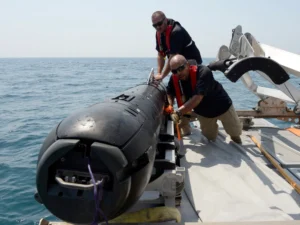The Navy said on Feb. 3 that production of the MK 18 Mod 2 Kingfish Unmanned Underwater Vehicle (UUV) program of record has completed.
MK 18 Mod 2 production started in 2012 via competitive contracts that Hydroid won with a vehicle based on its REMUS 600 vehicle. In 2020 HII [HII] bought Hydroid and made it part of the company’s Technical Solutions Unmanned Systems business unit.

Since the first production lot was started, over 90 MK 18 Mod 2 UUVs have been delivered to the fleet, the Navy said.
“The Department’s long-standing partnership with HII and their subcontractors demonstrates how mature technologies coupled with innovative acquisition approaches can speed the delivery of critical mission-enabling capabilities to our warfighting forces,” Capt. Jon Haase, program manager of the Expeditionary Missions program office (PMS 408), said in a statement.
The MK 18 Mod 2 is a major part of the Navy’s Expeditionary Mine Countermeasures (ExMCM) capabilities. The Navy said the ExMCM forces provide quick global countermeasure response capabilities supporting the Joint Force in various maritime areas.
Last July, the Navy awarded a contract to Leidos [LDOS] to design, test and build the next generation of ExMCM Medium Unmanned Undersea Vehicle (MUUV), dubbed the Viperfish. Viperfish aims to provide improved MCM capabilities over the MK 18 Mod 2 (Defense Daily, July 8).
Leidos and partner L3Harris Technologies [LHX] were selected over three competitors to develop and build the new MUUV in a joint acquisition venture. Leidos won a $12 million contract with options worth up to $358 million to design the vehicle.
The MUUV is made of one common baseline architecture for sensors and components, but divided between the Razorback torpedo tube launch and recovery variant and the Viperfish Maritime Expeditionary MCM UUV. The latter is focused on surface-launched and recovered mine countermeasures.
In November, Rear Adm. Casey Moton, program executive officer for Unmanned and Small Combatants, said the MUUV had finished an integrated baseline review and was set to execute the systems engineering review, system requirements review and system functional review (Defense Daily, Nov. 3).